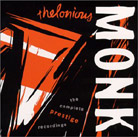March 2001
What makes this boxed set so interesting is that, when Monk signed his contract with Prestige, he was still in the process of creating his new, original music. Later, he'd almost stop composing altogether, and he began to replay, with infinite variations, his past works. Monk’s time with Prestige was short. It lasted slightly over two years. But, oh what music he laid down during that span -- trios, quartets, even his first solo tracks. And while he re-recorded some of the tunes he had already done for Blue Note, he also wrote some of his most enduring music while under contract to Prestige. Tunes such as "Blue Monk," "Trinkle Tinkle," "Little Rootie Tootie" (written for his son shortly after his birth) and "Bemsha Swing," to name but a few, made their first appearances on Prestige LPs. Included in the box's 33 tracks is an added bonus: Monk’s very first recordings -- a 1944 session with Coleman Hawkins (four cuts) done on the obscure Joe Davis label. These tracks alone would make this set a must-buy; they give us the opportunity to hear Monk very early in his career. Check out Monk’s playing on the first cut, "Flyin’ Hawk," and then listen to any of the Prestige tracks for a glimpse at just how quickly his musical style evolved. Then, look at the names of those Monk was playing with while at Prestige: Miles Davis, Sonny Rollins, Art Blakey, Max Roach, Percy Heath, Kenny Clarke, Milt Jackson, Frank Foster and Art Taylor -- all giants in the jazz world. And when you combine Monk’s association with such gifted artists, his musical productivity, and the advent at about the same time of the 33 1/3 LP record, well, you get the "Full Monty" of Monk stretching out, recording his music the way he heard it in his head for the first time. It’s a shame that Monk’s time with Prestige has received so little attention from scholars and music lovers over the years. Perhaps it’s because these recordings were preceded by his stint with Blue Note, that most famous of jazz labels, and were followed by his long stay with Riverside, where he received his greatest fame and made some of his best (and best-sounding) recordings. Perhaps also, it is because Monk’s time with Prestige was so short. Or -- and this is more likely -- it's a combination of many factors. But whatever the reasons, his time with Prestige has been given the short shift for too long. I suspect that this release will go a long way toward changing that situation. Sonically, The Complete Prestige Recordings is a knockout. This is about the best way you're ever going to hear this important music. I own some of the original recordings, and I’m here to tell you, this set, remastered in the analog domain utilizing JVC’s 20-bit K2 Super Coding, beats them all hollow. Everything sounds so much better here. But keep in mind that this high praise comes with an important qualification: These recordings were never state-of-the-art to begin with, so the improvements, while real, should be taken in context. Monk’s piano shines more easily on these CDs than on vinyl. About the only place vinyl wins is in the decay of each note -- as you might expect, you get a better sense of the piano’s sound decaying into silence on the LPs than on the CDs. Overall, the sound is far better than I’m used to on CD from a major label. And just wait till you hear the bass! Even on my bedroom system (Marantz integrated, Marantz CD player, PSB Image 1B speakers and a mixture of cables), the bass notes clearly made their presence felt. The drums also come through better, with more snap and weight -- again, with only the cymbal decay being better served on vinyl. But it is the music that takes center stage here. This period in Monk’s recording career has been undervalued for far too long. Until I listened to this three-CD set, I, too, had not paid close enough attention to these particular recordings -- and I love Monk’s music. Now, I’m not saying that this music is the equal of either his Blue Note or Riverside recordings, because it’s not. But it is far, far better than any of us have suspected. And while I’m sorry I waited so long to come to this realization, I’m almost giddy at the thought that we now have this remastering to rectify that problem. This boxed set may very well be my choice for reissue of the year (yeah, yeah, I know it’s early, but that’s how good this set is) and it gets my very highest recommendation. GO BACK TO: |
 Thelonious Monk - The Complete Prestige
Recordings
Thelonious Monk - The Complete Prestige
Recordings![[Reviewed on CD]](../format/regcd.gif) What
would you give to lay your hands on a time machine that could take you back and let you
listen to Thelonious Monk at the very height of his creative powers? For those of us with
quality sound systems, Thelonious Monk's The Complete Prestige Recordings is the
next best thing, and it doesn’t cost an arm and a leg, either. (And after all, what
are stereo systems, and the recordings to play on them, but time machines of a sort?)
What
would you give to lay your hands on a time machine that could take you back and let you
listen to Thelonious Monk at the very height of his creative powers? For those of us with
quality sound systems, Thelonious Monk's The Complete Prestige Recordings is the
next best thing, and it doesn’t cost an arm and a leg, either. (And after all, what
are stereo systems, and the recordings to play on them, but time machines of a sort?)